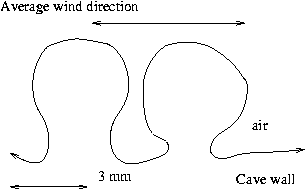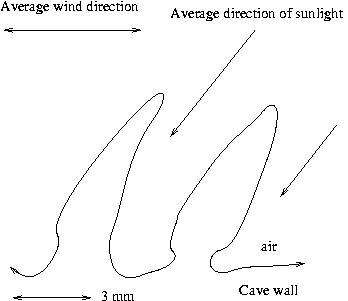This short article discusses a variety of cave coral found near cave entrances which appears to be elongated towards the light, and mentions organisms which appear to be agressive towards limestone.
In the northern entrance of Victoria Arch, Wombeyan Caves, there is a good example of this speleothem on the eastern wall near the tourist railing. The wall has a very rough surface, like an array of spikes. Each spike is about 4 to 6 mm long and the are about 3 to 4 mm apart. The spikes appear to be made of a calcite coralloid deposit with a colonies of blue-green algae all over the surface of the spikes. They are in a position which receives sunlight for part of the day, part of the year.
I was unsure when I first saw these in about 1999 as to whether they were a depositional form or an erosional form. On subsequent visits I convinced myself that they were depositional (but they have not been sampled).
I think what we are seeing here is a superposition of two effects: one physical / chemical, and one biological / chemical. The physical effect would be due to the location in a windy area, coupled with an intermittent supply of carbonate-rich water moving slowly down the surface. Those parts which stick out into the air stream more, such as rough surfaces or projections, would tend to outgas CO2 more than the more protected areas, leading to increased calcite deposition in the projecting areas. Water can move to the outside of coralloids fairly readily by capillary action, hence deposition at the outer ends of coralloids is enhanced. But this generally results in a rounded shape in the spelean environment, not the spiky surface which is seen in the entrance zone.
In the cave entrance zone, the presence of cyanobacteria would tend to enhance calcite deposition on the sunny or lightest side of the coralloid. This is discussed in Crayback Effects on Stalagmites. This would have the effect of making the tips of the coralloids point towards the lightest part of the entrance.
Coralloids are discussed in Hill & Forti.
| Development of Phototropic Coralloids |
|---|
| 1. Coralloid form without sunlight |

|
| 2. Coralloid form with sunlight |

|
On a somewhat related note, I have seen small circular pits in a limestone surface (sampled from a farm at Walli, NSW). These were microscopic in size (say 0,1 mm diameter). At the base of each pit was a small dark colony of (presumably) plants. The pits were about 1 mm deep. Elsewhere on the limestone, other small dark colonies (algae?) lie between the grains of calcite. They appear to bind the grains together although it is difficult to tell just by looking in a microscope as to which organisms are agressive to calcite and which are not. My guess is that on a limestone surface perhaps some erosion is due to slightly agressive organisms.
Cosmetic update September 2025; content updated 31st January 2006, created 12th August 2001.